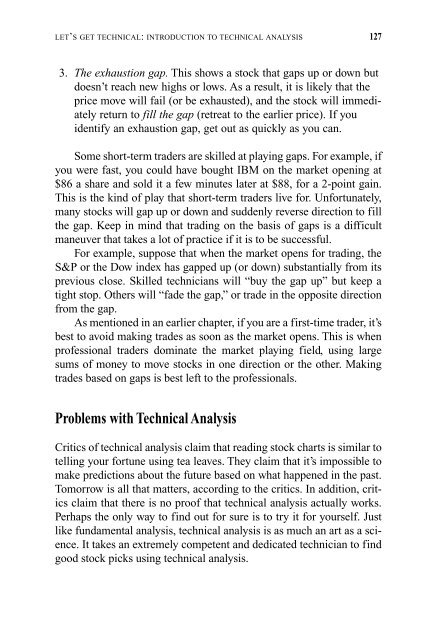Understanding Stocks
Understanding Stocks
Understanding Stocks
You also want an ePaper? Increase the reach of your titles
YUMPU automatically turns print PDFs into web optimized ePapers that Google loves.
LET’S GET TECHNICAL: INTRODUCTION TO TECHNICAL ANALYSIS 127<br />
3. The exhaustion gap. This shows a stock that gaps up or down but<br />
doesn’t reach new highs or lows. As a result, it is likely that the<br />
price move will fail (or be exhausted), and the stock will immediately<br />
return to fill the gap (retreat to the earlier price). If you<br />
identify an exhaustion gap, get out as quickly as you can.<br />
Some short-term traders are skilled at playing gaps. For example, if<br />
you were fast, you could have bought IBM on the market opening at<br />
$86 a share and sold it a few minutes later at $88, for a 2-point gain.<br />
This is the kind of play that short-term traders live for. Unfortunately,<br />
many stocks will gap up or down and suddenly reverse direction to fill<br />
the gap. Keep in mind that trading on the basis of gaps is a difficult<br />
maneuver that takes a lot of practice if it is to be successful.<br />
For example, suppose that when the market opens for trading, the<br />
S&P or the Dow index has gapped up (or down) substantially from its<br />
previous close. Skilled technicians will “buy the gap up” but keep a<br />
tight stop. Others will “fade the gap,” or trade in the opposite direction<br />
from the gap.<br />
As mentioned in an earlier chapter, if you are a first-time trader, it’s<br />
best to avoid making trades as soon as the market opens. This is when<br />
professional traders dominate the market playing field, using large<br />
sums of money to move stocks in one direction or the other. Making<br />
trades based on gaps is best left to the professionals.<br />
Problems with Technical Analysis<br />
Critics of technical analysis claim that reading stock charts is similar to<br />
telling your fortune using tea leaves. They claim that it’s impossible to<br />
make predictions about the future based on what happened in the past.<br />
Tomorrow is all that matters, according to the critics. In addition, critics<br />
claim that there is no proof that technical analysis actually works.<br />
Perhaps the only way to find out for sure is to try it for yourself. Just<br />
like fundamental analysis, technical analysis is as much an art as a science.<br />
It takes an extremely competent and dedicated technician to find<br />
good stock picks using technical analysis.

















